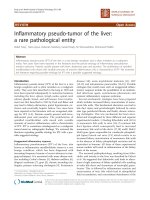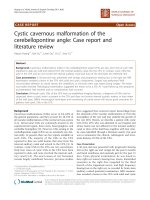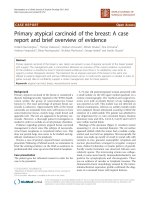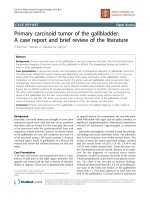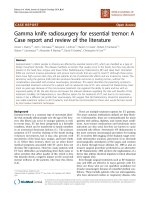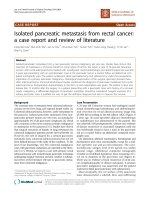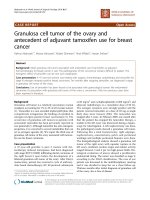báo cáo khoa học: "Solitary fibrous tumor of the liver: a case report" docx
Bạn đang xem bản rút gọn của tài liệu. Xem và tải ngay bản đầy đủ của tài liệu tại đây (2.5 MB, 3 trang )
CAS E REP O R T Open Access
Solitary fibrous tumor of the liver: a case report
Ke Sun
1
, Jian-Ju Lu
2
, Xiao-Dong Teng
1
, Li-Xiong Ying
1
and Jian-Feng Wei
2*
Abstract
Hepatic solitary fibrous tumor (SFT) is a rare tumor originating from the mesenchyme. Here we report a new case
of SFT in the liver and review the clinical presentation, radiological and operative findings, diagnosis, treatment,
and outcome. The patient was a 59-year-old man who presented with progressive fatigue for 3 months and an
abdominal mass for 3 days. On laboratory tests, no abnormality was detected except that abdominal
ultrasonography revealed a 9.0 × 6.2 cm hypoechogenic mass in the left lobe of the liver. A computed
tomographic scan confirmed a hypodense lesion in the left lobe of the liver. The patient underwent left
hepatectomy. SFT was diagnosed on the basis of histopath ological findings. The patient was free from all
symptoms and had no signs of local recurrence after 24 months’ follow up .
Background
Solitary fibrous tumor (SFT) is a rare spindle-cell neo-
plasm of mesenchymal origin, first described by Klem-
perer and Robin in the visceral pleura in 1931 [1]. It
usuallyisfoundinthethoraciccavityandpleura,but,
rarely, it can involve other organs such as the mediasti-
num [2], the skin [3], soft tissue [4], the thyroid gland
[5], the orbit [6], and others. Although most solitary
fibrous tumors have benign behavior, some may have
malignant features such as metastasis and recurrence.
Clinical or radiological findings are not specific and can-
not exclude malignancy. Preoperative cytology may be
inconclusive or misleading. Currently, the prevailing
view is that immunohistology, including CD34 and
vimentin, should be used to precisely diagnose SFT [7].
The outcome of an SFT of the liver is mostl y rel ated to
resectability [8]. Thu s, complete surgical removal of the
neoplasm is most commonly proposed. We report a
case of SFT of the liver and review the literature to date.
Case Presentation
A 59-year-old man was admitted to our hospital because
of progressive fatigue for 3 months and an abdominal
mass for 3 days. The patient had no history of viral
hepatitis. Laboratory tests, including routine biochemis-
try, liver function, and tumor markers, were normal.
A plain chest X-ray was normal. Abdominal ultrasono-
graphy revealed a 9.0 × 6.2 cm hypoechogenic mass in
the left lobe of the liver. Computed tomography (CT)
demonstrated a large heterogeneous circumscribed mass
in the left hepatic lobe and contrast enhancement in the
arterial and portal phases (Figure 1A, B, C). Left hepa-
tectomy was performed, and the patient recovered with-
out complications.
Grossly, the tumor was a large, gray-white, lobulated,
well-circumscr ibed partially encapsulated mass, measur-
ing 9 × 7 × 6 cm. In the peripheral liver parenchyma,
the vascular structure an d bile duct were compressed,
and no cirrhosis or fibrosis was observed (Figure 1C).
Histologically, the tumor was composed principally of
spindle cells arranged in short, ill-defined fascicles in
some zones a nd randomly in others (Figure 2A, B).
They were intermi ngled with striking areas of hyaliniza-
tion. The vascular pattern varied from narrow vascular
clefts to gaping, branching vascular channels. Cystic
degeneration was present. Little mitotic activity was
observed (fewer than 1-2 mitoses in 1 0 high-power
fields (HPF)), and these foci showed more dense cellu-
larity and more n uclear atypia; this was considered to
represent low-grade malignant transformation. This
tumor also showed irregular infiltration of the peripheral
liver (Figure 2A). Little inflammatory cell infiltration
without necrosis was seen.
Immunohistoche mically, the tumor cells were stro ngly
positive for CD34 (Figure 2C), CD99 (Figure 2D), Bcl-2,
and vimentin and negative for smooth muscle actin
(SMA), CD31, cytokeratin, S-100, CD117, and epithelial
* Correspondence:
2
Department of Hepatobiliary Surgery, the First Affiliated Hospital, College of
Medicine, Zhejiang University, 79 Qingchun Road, Hangzhou, Zhejiang,
310003, PR China
Full list of author information is available at the end of the article
Sun et al . World Journal of Surgical Oncology 2011, 9:37
/>WORLD JOURNAL OF
SURGICAL ONCOLOGY
© 2011 Sun et al; licensee BioMe d Central Ltd. This is an Open Access article distributed under the terms of the Creative Commons
Attribution License ( g/li censes/by/2.0), which permits unrestricted use, distribution, and reproduction in
any medium, provided the original wor k is properly cited.
membrane antigen ( EMA). A solitary fibrous tumor of
the liver was diagnosed pathologically. The patient was
free from any symptoms and without local re currence
for 24 months.
Discussion
Primary solitary fibrous tumor of the liver is an extre-
mely rare neoplasm. Individual case reports are infre-
quent. The first description of this type of tumor
involving the liver may be that provided by Nevius and
Friedman in 1959 [9]. A review of the literature revealed
fewer than 40 reported SFTs of the liver to date [7,8,10].
These tumors mainly occurred in women, at a ratio of
71.7 percent female to 28.3 percent male. The mean age
was58.9yearsold.Thetumorcanbefoundineither
the right or the left hepatic lobe. Clinically, most
patients may be asymptomatic, whereas other patients
are symptomatic with abdominal pain, abdominal full-
ness and mass, weight loss, and fatigue when the tumor
grows. Some present with alterations of liver tests and
compression of biliary ducts leading to cholestasis [11].
In general, the clinical presentation of patients with SFT
usually is mild and not distinctive from that of other
lesions of the liver.
The radiological findings may su ggest the diagnosis of
SFT, but benign or malignant hepatic tumors such as
hepatocellular carcinoma, sarcoma, leiomyoma, and
inflammatory pseudotumor may have similar features
[11]. Thus, the radiologica l findings are nonspecific and
cannot distinguish between benign and malignant
tumors. Therefore, in the present case, the diagnosis of
SFT of the liver was based on the association of typical
histological and immunohistochemical features. C D34
positivity distinguishes SFT from other spindle-cell
tumors [12], and it is necessary to combine other mar-
kers for differential diagnosis.Inourcase,thetumor
cells were strongly positive for CD34, CD99, Bcl-2, and
vimentin and negativ e for smooth muscle actin (SMA),
CD31, cytokeratin, S-100, CD117, and epithelial mem-
brane antigen (EMA).
ThepathologicfeaturesoftheSFToftheliver
described here resemble those described for solitary
fibroustumorsofotherlocations [13]. Typical SFTs
show a patternless arch itecture charac terized by a com-
bination of alternating hypocellular and hypercellular
areas separated from each other by thick bands of hyali-
nized, somewhat keloidal collagen and branching
haem angiopericytoma-like vessels. These features differ-
entiate SFTs from other liver mesenchymal tumors.
Immunohistochemically, SFTs consistently express
CD34, are variably positive for CD99 and Bcl-2, and
lack cytokeratin or other mesothelial markers. The pre-
sence of mitotic figures is associated with but not pre-
dictive of aggressive clinical behavior [14]. T he
histologic features of this malignancy include high cellu-
larity and mitotic activity, pleomorphism, necrosis, and
local invasion [8].
The differential diagnosis includes leiomyoma (con-
sists of intersecting bundles of smooth muscle cells;
SMA positive, CD34 negative) [15], inflammatory pseu-
dotumor (consists of myofibroblasts, fibroblast cells
mixed with inflammatory cells, predominantly plasma
cells, lymphocytes, as well as eosinophils; SMA positive,
Figure 1 Single mass in the left hepatic lobe.(A)CTscan
demonstrated a mass (9.0 × 6.2cm) in left hepatic lobe. (B) and (C)
Contrast enhancement in arterial and portal phases was found in
the mass. (D) Grossly, a large, gray-white, lobulated, well-
circumscribed, partially encapsulated mass was removed after
hepatoectomy.
Figure 2 Histological section of the SFT.(A)and(B)Thetumor
was composed principally of spindle cells arranged in short, ill-
defined fascicles in some zones and randomly in others (A; H & E
10×; B; 40×). Immunohistochemically, the tumor cells were strongly
positive for CD34 (C; 20×) and CD99 (D; 20×).
Sun et al . World Journal of Surgical Oncology 2011, 9:37
/>Page 2 of 3
vimentin positive, and CD34 negative) [16], fibrosar-
coma (forms a “herringbone” pattern; CD34 negative),
and stromal tumor (CD117 and CD34 positive) [11].
Although most cases have benign clinical behavior, there
is no strict correlation between histological findings and
biological behavior. Some may have malignant histological
features and recur locally or metastasize [17]. Therefore, a
complete surgical resection is the first choice for treatment
and is curative in most cases. Follow-up surveillance is
necessary. According to the limited literature on hepatic
SFTs, all but three patients underwent surgical resection .
There is only one report of distant metastasis to the bone,
and it was successfully treated with chemotherapy [17].
Among 92 cases of extrathora cic SFT, ten cases with aty-
pical features including high cellularity, >4 mitoses/10
HPF, nuclear pleomorphism, and necrosis were associated
with aggressive clinical behavior. Among these ten
patients, eight had local recurrence or distant metastases
[14]. Interestingly, one widely metastatic tumor did not
have any atypical features in the primary lesion but
acquired four such features in the metastatic foci. These
findings confirm that the behavior of extrathoracic SFTs is
unpredictable. Due to the rarity of this tumor, the prog-
nosis has not been well defined [8]. Therefore, patients
with SFTs in any location require careful long-term follow
up, and it is probably unwise to regard any such lesion as
definitely benign [14].
Conclusion
We observed a rare case of SFT of the liver. Correct
interpretation of unique pathological findings and CD34
immunoreactivity plays a significant role in differentiat-
ing SFT from other spindle-cell neoplasms of the liver.
A complete surgical resection is the treatment of choice
and is curative in most cases, and follow-up surveillance
is necessary. The outcome of SFTs is mostly related to
resectability rather than pathologic grade or tumor size.
Given the limited number of cases reported in the litera-
ture, it i s still difficult to establish the long-term prog-
nosis of this disease.
Consent
Written informed consent was obtained from the patient
for publication of this case report and any accompany-
ing images. A copy of the written consent is avail able
for review by the Editor in Chief of this journal.
Acknowledgements
The English in this document has been checked by at least two professional
editors, both native speakers of English. For a certificate, please see:
/>Author details
1
Department of Pathology, the First Affiliated Hospital, College of Medicine,
Zhejiang University, 79 Qingchun Road, Hangzhou, Zhejiang, 310003, PR
China.
2
Department of Hepatobiliary Surgery, the First Affiliated Hospital,
College of Medicine, Zhejiang University, 79 Qingchun Road, Hangzhou,
Zhejiang, 310003, PR China.
Authors’ contributions
KS, JFW, and XDT conceived the concept, participated in drafting the
manuscript, and conducted critical review. JJL took part in the care of the
patient, assembled data, and participated in writing the manuscript. LXY
carried out the histopathological evaluation and reviewed pathology. All
authors read and approved the final manuscript.
Competing interests
The authors declare that they have no competing interests.
Received: 7 July 2010 Accepted: 29 March 2011
Published: 29 March 2011
References
1. Klemperer P, Coleman BR: Primary neoplasms of the pleura. A report of
five cases. Am J Ind Med 1992, 22:1-31.
2. Sawauchi S, Arakawa H, Taya K, Terao T, Nakazaki H, Numoto RT,
Yamaguchi Y, Hashimoto T, Abe T: [Solitary fibrous tumor of the fourth
ventricle: case report]. No Shinkei Geka 2003, 31:551-555.
3. Cowper SE, Kilpatrick T, Proper S, Morgan MB: Solitary fibrous tumor of the
skin. Am J Dermatopathol 1999, 21:213-219.
4. Hasegawa T, Hirose T, Seki K, Yang P, Sano T: Solitary fibrous tumor of the
soft tissue. An immunohistochemical and ultrastructural study. Am J Clin
Pathol 1996, 106:325-331.
5. Farrag TY, Micchelli S, Tufano RP: Solitary fibrous tumor of the thyroid
gland. Laryngoscope 2009, 119:2306-2308.
6. Westra WH, Gerald WL, Rosai J: Solitary fibrous tumor. Consistent CD34
immunoreactivity and occurrence in the orbit. Am J Surg Pathol 1994,
18:992-998.
7. Vennarecci G, Ettorre GM, Giovannelli L, Del Nonno F, Perracchio L, Visca P,
Corazza V, Vidiri A, Visco G, Santoro E: Solitary fibrous tumor of the liver. J
Hepatobiliary Pancreat Surg 2005, 12:341-344.
8. Ji Y, Fan J, Xu Y, Zhou J, Zeng HY, Tan YS: Solitary fibrous tumor of the
liver. Hepatobiliary Pancreat Dis Int 2006, 5:151-153.
9. Nevius DB, Friedman NB: Mesotheliomas and extraovarin thecomas with
hypoglycemic and nephrotic syndromes. Cancer 1959, 12:1263-1269.
10. Korkolis DP, Apostolaki K, Aggeli C, Plataniotis G, Gontikakis E, Volanaki D,
Sebastiadou M, Dimitroulopoulos D, Xinopoulos D, Zografos GN,
Vassilopoulos PP: Solitary fibrous tumor of the liver expressing CD34 and
vimentin: a case report. World J Gastroenterol 2008, 14:6261-6264.
11. Fuksbrumer MS, Klimstra D, Panicek DM: Solitary fibrous tumor of the
liver: imaging findings. AJR Am J Roentgenol 2000, 175:1683-1687.
12. Guglielmi A, Frameglia M, Iuzzolino P, Martignoni G, De Manzoni G,
Laterza E, Veraldi GF, Girlanda R: Solitary fibrous tumor of the liver with
CD 34 positivity and hypoglycemia. J Hepatobiliary Pancreat Surg 1998,
5:212-216.
13. Kwak SY, Gwak GY, Yun WK, Kim HJ, Do IG, Joh JW, Park CK: [A case of
solitary fibrous tumor of the liver]. Korean J Hepatol 2007, 13:560-564.
14. Vallat-Decouvelaere AV, Dry SM, Fletcher CD: Atypical and malignant
solitary fibrous tumors in extrathoracic locations: evidence of their
comparability to intra-thoracic tumors.
Am J Surg Pathol 1998,
22:1501-1511.
15. Reinertson TE, Fortune JB, Peters JC, Pagnotta I, Balint JA: Primary
leiomyoma of the liver. A case report and review of the literature. Dig
Dis Sci 1992, 37:622-627.
16. Coffin CM, Watterson J, Priest JR, Dehner LP: Extrapulmonary inflammatory
myofibroblastic tumor (inflammatory pseudotumor). A clinicopathologic
and immunohistochemical study of 84 cases. Am J Surg Pathol 1995,
19:859-872.
17. Yilmaz S, Kirimlioglu V, Ertas E, Hilmioglu F, Yildirim B, Katz D, Mizrak B:
Giant solitary fibrous tumor of the liver with metastasis to the skeletal
system successfully treated with trisegmentectomy. Dig Dis Sci 2000,
45:168-174.
doi:10.1186/1477-7819-9-37
Cite this article as: Sun et al.: Solitary fibrous tumor of the liver: a case
report. World Journal of Surgical Oncology 2011 9:37.
Sun et al . World Journal of Surgical Oncology 2011, 9:37
/>Page 3 of 3

